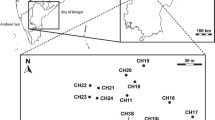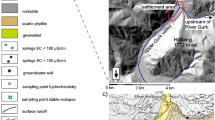Abstract
Crystalline aquifers of semi-arid southern India represent a vital water resource for farming communities. A field study is described that characterizes the hydrodynamic functioning of intensively exploited crystalline aquifers at local scale based on detailed well monitoring during one hydrological year. The main results show large water-table fluctuations caused by monsoon recharge and pumping, high spatial variability in well discharges, and a decrease of well yields as the water table decreases. Groundwater chemistry is also spatially variable with the existence of aquifer compartments within which mixing occurs. The observed variability and compartmentalization is explained by geological heterogeneities which play a major role in controlling groundwater flow and connectivity in the aquifer. The position of the water table within the fracture network will determine the degree of connectivity between aquifer compartments and well discharge. The presented aquifer conceptual model suggests several consequences: (1) over-exploitation leads to a drop in well discharge, (2) intensive pumping may contribute to the hydraulic containment of contaminants, (3) groundwater quality is highly variable even at local scale, (4) geological discontinuities may be used to assist in the location of drinking-supply wells, (5) modeling should integrate threshold effects due to water-table fluctuations.
Résumé
Les aquifères de socle des régions semi-arides du sud de l’Inde représentent une ressource en eau vitale pour les communautés agricoles. Cette étude sur un site expérimental a pour but de caractériser le fonctionnement hydrodynamique d’un aquifère de socle fortement sollicité par les pompages sur la base d’un suivi détaillé de forages durant une année hydrologique. Les résultats principaux montrent une fluctuation importante de la nappe causée par la recharge durant la mousson et les pompages, une grande variabilité spatiale des débits des forages, et une diminution des débits concomitante de la baisse du niveau de la nappe. La chimie des eaux souterraines est également variable spatialement avec l’existence de compartiments au sein desquels un mélange d’eau opère. La variabilité et compartimentation observées s’expliquent par la présence d’hétérogénéités géologiques qui contrôlent les écoulements et la connectivité de l’aquifère. La position de la nappe au sein du réseau de fractures détermine à la fois le degré de connectivité des différents compartiments et le débit des ouvrages. Le modèle conceptuel proposé de l’aquifère semble indiquer plusieurs conséquences : (1) la surexploitation conduit à une diminution des débits pompés, (2) le pompage intensif peut contribuer au confinement hydraulique des contaminants, (3) la qualité des eaux souterraines est très variable même à l’échelle locale, (4) les discontinuités géologiques peuvent être utilisées à bon escient pour l’emplacement d’ouvrages d’alimentation en eau potable, (5) les simulations doivent intégrer les effets de seuil générés par les fluctuations de nappe.
Resumen
Los acuíferos cristalinos en el sur semiárido de la India representan un recurso vital de agua para las comunidades agrícolas. Se describe un estudio de campo que caracteriza el funcionamiento hidrodinámico de los acuíferos cristalinos intensivamente explotados a la escala local basado en el monitoreo detallado de pozos durante un año hidrológico. Los principales resultados muestran grandes fluctuaciones del nivel freático causadas por la recarga monzónica y el bombeo, alta variabilidad espacial en la descarga de pozos, y un descenso de los rendimientos de los pozos a medida que los niveles freáticos se profundizan. La química del agua subterránea también es variable espacialmente con la existencia de compartimentos acuíferos dentro de los cuales existen mezclas. La variabilidad observada y la compartimentalización se explican por las heterogeneidades geológicas que juegan un rol significativo en controlar el flujo de agua subterránea y la conectividad en el acuífero. La posición del nivel freático dentro de la red de fracturas determina el grado de conectividad entre los compartimentos acuíferos y la descarga de pozos. El presente modelo conceptual de acuífero sugiere varias consecuencias: (1) la sobreexplotación conduce a una caída en la descarga de los pozos, (2) el bombeo intensivo puede contribuir a la contención hidráulica de contaminantes, (3) la calidad del agua subterránea es altamente variable aún a escala local, (4) las discontinuidades geológicas pueden ser usadas para ayudar en la ubicación de pozos de abastecimiento de agua potable, (5) el modelado debe integrar los efectos umbral debidos a las fluctuaciones de los niveles freáticos.
摘要
印度南部半干旱地区的结晶岩含水层是农业用水的重要水源。本文通过现场踏勘,依据一个水文年内的详细观测结果,在本地尺度上描述了密集开采下结晶岩含水层的水动力响应。主要结果表明,大的水位波动主要是由季风补给、开采、井排泄的高度空间变率及水位降低引起的出水量降低所致。有混合发生的含水层单元内地下水水化学也有空间变化。地质的非均质性是控制地下水流和含水层水力联系的主要因素,据此解释了观测到的变化和含水层划分。裂隙网络中水位的高低决定着含水层间的水力联系和井排泄量的大小。提出的含水层概念模型表明:(1)过量开采地下水导致井的排泄量下降; (2)强烈开采可能导致污染物集中;(3)即使在本地尺度上,地下水质的变化也较大;(4)地质不连续面有利于确定饮用水供水井的位置;(5)模型应该考虑水位波动导致的阈值效应。
Resumo
Os aquíferos cristalinos na região semi-árida do Sul da Índia representam um recurso de água vital para as comunidades agrícolas. Faz-se a descrição de um estudo de campo em que se caracteriza o funcionamento hidrodinâmico, à escala local, de aquíferos cristalinos intensivamente explorados, com base na monitorização detalhada de furos durante um ano hidrológico. Os principais resultados evidenciam grandes flutuações do nível piezométrico, provocadas pela recarga das monções e pela extração, elevada variabilidade espacial no caudal das captações e um decréscimo no caudal dos furos em função do rebaixamento dos níveis piezométricos. A química da água subterrânea também varia espacialmente com a existência de compartimentos no aquífero, dentro dos quais ocorre mistura. A variabilidade e compartimentação observadas são explicadas pelas heterogeneidades geológicas, as quais desempenham um papel fundamental no controlo do fluxo subterrâneo e na conectividade dentro do aquífero. A posição do nível piezométrico dentro da rede de fraturas vai determinar o grau de conetividade entre os compartimentos do aquífero e o caudal das captações. O modelo conceptual apresentado para o aquífero sugere várias consequências: (1) a sobre-exploração leva a uma diminuição na descarga das captações, (2) a bombagem intensiva pode contribuir para a contenção hidráulica de contaminantes, (3) a qualidade da água subterrânea é altamente variável, mesmo à escala local, (4) as descontinuidades geológicas podem ser utilizadas para auxiliar na localização de captações de abastecimento, (5) a modelação deve integrar os efeitos limite provocados pelas flutuações do nível piezométrico.











Similar content being viewed by others
References
Acworth RI (1987) The development of crystalline basement aquifers in a tropical environment. Q J Eng Geol 20:265–272
Babiker M, Gudmundsson A (2004) The effects of dykes and faults on groundwater flow in an arid land: the Red Sea Hills, Sudan. J Hydrol 297:256–273
Barker RD, White CC, Houston JFT (1992) Borehole siting in an African accelerated drought relief project. Geol Soc Spec Publ 66:183–201
Briz-Kishore BH (1993) Assessment of yield characteristics of granitic aquifers in South India. Ground Water 31(6):921–928
Chandra S, Rao VA, Krishnamurthy NS, Dutta S, Ahmed S (2006) Integrated studies for characterization of lineaments used to locate groundwater potential zones in a hard rock region of Karnataka, India. Hydrogeol J 14:767–776
Chilton PJ, Foster SSD (1995) Hydrogeological characterization and water-supply potential of basement aquifers in tropical Africa. Hydrogeol J 3(1):36–49
Courtois N, Lachassagne P, Wyns R, Blanchin R, Bougaïré FD, Somé S, Tapsoba A (2010) Large-scale mapping of hard-rock aquifer properties applied to Burkina Faso. Ground Water 48(2):269–283. doi:10.1111/j.1745-6584.2009.00620.x
Day-Lewis FD, Hsieh PA, Gorelick SM (2000) Identifying fracture-zone geometry using simulated annealing and hydraulic connection data. Water Resour Res 36(7):1707–1721
Day-Lewis FD, Lane JW, Harris JM, Gorelick SM (2003) Time-lapse imaging of saline tracer transport in fractured rock using difference-attenuation radar tomography. Water Resour Res 39(10):1290. doi:10.1029/2002WR001722
Dewandel B, Lachassagne P, Wyns R, Maréchal JC, Krishnamurthy NS (2006) A generalized 3-D geological and hydrogeological conceptual model of granite aquifers controlled by a single or multiple weathering. J Hydrol 330:260–284
Dewandel B, Perrin J, Ahmed S et al (2010) Development of a tool for managing groundwater resources in semi-arid hard rock regions: application to a rural watershed in south India. Hydrol Proc 24(19):2784–2797
Fraenkel PL (1986) Water lifting devices. FAO Irrigation and Drainage Paper 43, FAO, Rome
Gustafson G, Krásný J (1994) Crystalline rock aquifers: their occurrence, use and importance. Appl Hydrogeol 2:64–75
Henriksen H, Braathen A (2006) Effects of fracture lineaments and in-situ rock stresses on groundwater flow in hard rocks: a case study from Sunnfjord, western Norway. Hydrogeol J 14:444–461
Howard KWF, Hughes M, Charlesworth DL, Ngobi G (1992) Hydrogeologic evaluation of fracture permeability in crystalline basement aquifers of Uganda. Appl Hydrogeol 1:55–65
Jones MJ (1985) The weathered zone aquifers of the basement complex areas of Africa. Q J Eng Geol Hydrogeol 18:35–46
Krishnamurthy J, Kumar NV, Jayaraman V, Manivel M (1996) An approach to demarcate ground water potential zones through remote sensing and geographical information system. Int J Remote Sens 17:1867–1884
Lachassagne P, Wyns R, Bérard P, Bruel T, Chéry L, Coutand T, Desprats JF, Le Strat P (2001) Exploitation of high-yield in hard-rock aquifers: downscaling methodology combining GIS and multicriteria analysis to delineate field prospecting zones. Ground Water 39(4):568–581
Le Borgne T, Bour O, Paillet FL, Caudal JP (2006) Assessment of preferential flow path connectivity and hydraulic properties at single-borehole and cross-borehole scales in a fractured aquifer. J Hydrol 328:347–359. doi:10.1016/j.jhydrol.2005.12.029
Maréchal JC, Dewandel B, Subrahmanyam K (2004) Use of hydraulic tests at different scales to characterize fracture network properties in the weathered-fractured layer of a hard rock aquifer. Water Resour Res 40:W11508, 17 pp
Maréchal JC, Dewandel B, Ahmed S, Galeazzi L, Zaidi FK (2006) Combined estimation of specific yield and natural recharge in semi-arid groundwater basin with irrigated agriculture. J Hydrol 329:281–293. doi:10.1016/j.jhydrol.2006.02.022
Maréchal JC (2010) Editor′s message: the sunk cost fallacy of deep drilling. Hydrogeol J 18:287–289
Paillet FL, Hess AE, Cheng CH, Hardin E (1987) Characterization of fracture permeability with high-resolution vertical flow measurements during borehole pumping. Ground Water 25(1):28–40
Paillet FL (1993) Using borehole geophysics and cross-borehole flow testing to define hydraulic connections between fracture zones in bedrock aquifers. J Appl Geophys 30:261–279
Paillet FL (2000) A field technique for estimating aquifer parameters using flow log data. Ground Water 38(4):510–521
Perrin J, Mascré C, Massuel S et al (2009) Tank management in Andhra Pradesh, India: percolation vs. irrigation. IAHS Publication 330, IAHS, Wallingford, UK, pp 28–33
Perrin J, Mascré C, Pauwels H, Ahmed S (2011) Solute recycling: an emerging threat to groundwater resources in southern India? J Hydrol 398:144–154. doi:10.1016/j.jhydrol.2010.12.024
Reddy DV, Nagabhushanam P, Sukhija BS, Reddy AGS (2009) Understanding hydrological processes in a highly stressed granitic aquifer in southern India. Hydrol Process 23:1282–1294. doi:10.1002/hyp.7236
Rushton KR (2003) Groundwater Hydrology: conceptual and computational models. Wiley, England, 416 pp
Sander P (2007) Lineaments in groundwater exploration: a review of applications and limitations. Hydrogeol J 15(1):71–74
Sander P, Minor TB, Chesley MM (1997) Groundwater exploration based on lineament analysis and reproducibility tests. Ground Water 35:888–894
Silliman S, Robinson R (1989) Identifying fracture interconnections between boreholes using natural temperature profiling: I. conceptual basis. Ground Water 27(3):393–402
Taylor R, Howard K (2000) A tectono-geomorphic model of the hydrogeology of deeply weathered crystalline rock: evidence from Uganda. Hydrogeol J 8(3):279–294
Wright EP (1992) The hydrogeology of crystalline basement aquifers in Africa. Geol Soc Spec Publ 66:1–27
Wyns R, Baltassat JM, Lachassagne P, Legchenko A, Vairon J, Mathieu F (2004) Application of SNMR soundings for groundwater reserves mapping in weathered basement rocks (Brittany, France). Bull Soc Geol Fr 175(1):21–34
Zaidi FK, Ahmed S, Maréchal JC, Dewandel B (2007) Optimizing a piezometric network in the estimation of the groundwater budget: a case study from a crystalline-rock watershed in southern India. Hydrogeol J 15:1131–1145
Acknowledgements
We are indebted to the students (J. Cachera, E. Bougon, M. Ahmad) who contributed to the collection of field data and to Mr Wajiduddin for his continuous involvement in field activities. The community of Sangapur is warmly thanked for its support and interest in this research project. We are grateful to the Editors and two anonymous reviewers for their valuable comments on the original manuscript.
Author information
Authors and Affiliations
Corresponding author
Rights and permissions
About this article
Cite this article
Perrin, J., Ahmed, S. & Hunkeler, D. The effects of geological heterogeneities and piezometric fluctuations on groundwater flow and chemistry in a hard-rock aquifer, southern India. Hydrogeol J 19, 1189–1201 (2011). https://doi.org/10.1007/s10040-011-0745-y
Received:
Accepted:
Published:
Issue Date:
DOI: https://doi.org/10.1007/s10040-011-0745-y




